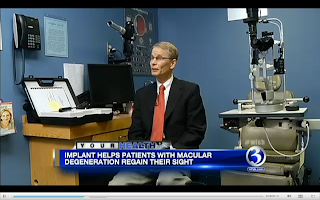Dr. Randolph Kinkade, Connecticut optometrist and founding member of the International Academy of Low Vision Specialists, is part of the doctor team offering a new treatment for macular degeneration patients in Connecticut.
 |
| Dr. Randolph Kinkade during an IMT interview. Link to Television Interview |
The Implantable Miniature Telescope (IMT) technology reduces the impact of vision loss due to advanced macular degeneration. The telescope projects the objects the patient is looking at onto healthier areas of the light-sensing retina in the back of the eye not degenerated by the disease.
Macular Degeneration is the leading cause of vision loss in seniors. There are approximately two million senior Americans who have the advanced form of this disease affecting the central region of the retina called the macula. The macula is responsible for detailed vision like reading, writing, watching television, seeing faces and driving.
Dr. Kinkade has been fitting Spectacle Miniature Telescopes (SMTs) for over twenty years. These special glasses have prescriptions built into tiny telescopes mounted into eyeglasses.
 |
| An Implantable Miniature Telescope next to a Spectacle Miniature Telescope.
|
The U.S. Food and Drug Administration approved the IMT in 2010. The surgical procedure involves removing the eye's natural lens that has a cataract and replacing the lens with the telescope implant. The tiny telescope is implanted behind and through the pupil.
 |
| Looking through a miniature telescope. |
"While it doesn’t cure macular degeneration, it will help improve the vision of patients and help maximize their vision," said Dr. Kinkade. It will help them resume some of their favorite activities and regain independence".
The telescopic implant costs approximately $15,000. That does not include the cost of surgery and rehabilitation. The IMT is covered by Medicare for eligible patients.
"After the implantation, patients enroll in an extensive rehabilitation program that involves training them to use the device", said Dr. Kinkade. "Rehabilitation takes about six months to a year is a very critical component."
 |
| Dr. Kinkade looking through an External Telescopic Simulator. |
Patients must reteach their brain to see differently. The eye with the implant see things larger and centrally. The other eye see things their normal size and peripherally. This is unique and different way of seeing.
Dr. Kinkade cautions the surgery is for select individuals. Candidates must be 75 years of age or older, have dry macular degeneration and no longer be a candidate for drug treatments. Patients are excluded if they have had previous cataract surgery in the eye to be implanted. There are additional eye shape and eye health requirements.
There is good news for patients who are not candidates for the IMT, because they are quite often candidates for the SMT.
 |
| Dr. Kinkade and patient wearing a Spectacle Miniature Telescope. |
(800) 756-0766
Cheshire - Danbury - Farmington - Litchfield - Manchester - Norwalk - Waterford

































